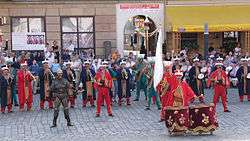Ottoman military band
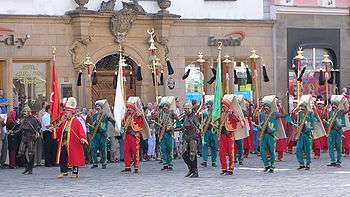
Ottoman military bands are thought to be the oldest variety of military marching bands in the world. Though they are often known by the word mahtar (مهتر; mehter in Ottoman Turkish) in the West, that word, properly speaking, refers only to a single musician in the band. In Ottoman, the band was generally known as mehterân, though those bands used in the retinue of a vizier or prince were generally known as mehterhane (مهترخانه, meaning roughly, "a gathering of mehters", the band as a whole is often termed mehter bölüğü ("mehter company [troop]"), mehter takımı ("mehter platoon"). In the West, the band's music is also often called Janissary music because the janissaries formed the core of the bands.
History
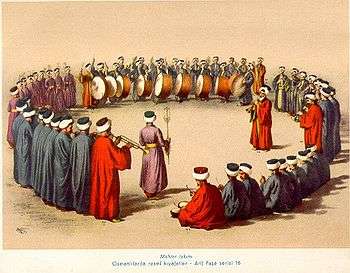
It is believed that individual instrumentalists may have been mentioned in the 8th century Orkhon inscriptions.[1][2][3][4] Such military bands as the mehters, however, were not definitively mentioned until the 13th century.[5] It is believed that the first "mehter" was sent to Osman I by the Seljuk Sultan Alaeddin Keykubad III as a present along with a letter that salutes the newly formed state. From then on every day after the afternoon prayer; "mehter" played for the Ottoman ruler. The notion of a military marching band, such as those in use even today, began to be borrowed from the Ottoman Empire in the 16th century. The sound associated with the mehterân also exercised an influence on European classical music, with composers such as Joseph Haydn, Wolfgang Amadeus Mozart, and Ludwig van Beethoven all writing compositions inspired by or designed to imitate the music of the mehters.[6]
In 1826, the music of the mehters fell into disfavor following Sultan Mahmud II's abolition of the Janissary corps, who had formed the core of the bands. Subsequent to this, in the mid and late 19th century, the genre went into decline along with the Ottoman Empire. In 1911, as the empire was beginning to collapse, the director of Istanbul's military museum attempted a somewhat successful revival of the tradition, and by 1953—so as to celebrate the 500-year anniversary of the Fall of Constantinople to the forces of Sultan Mehmed II—the tradition had been fully restored as a band of the Turkish Armed Forces.
Today, the music of the mehters is largely ceremonial and considered by many Turks as a stirring example of heroism and a reminder of Turkey's historical past. Though the majority of the pieces performed by them are newer compositions.
Today, the Armed Forces Mehter Unit (Mehter Bölüğü) is the traditional band of the Turkish Armed Forces and it performs regularly at the Military Museum (Askeri Müze) in Istanbul as well as during certain state ceremonies. There is also the Ministry of Culture Istanbul Historical Music Ensemble.[7]
The Mehteran identity
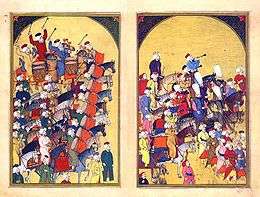
Mehter (Modern Turkish) or Mehteran (Ottoman Turkish مهتران literally "pre-eminences") was the type of military ensemble within the Ottoman army which played martial tunes during military campaigns. The mehteran was usually associated with the Janissary corps of the Army, usually composed of Christian converts to Islam. The music of mehteran is called "mehter marşı" or "mehter march". "Mehterhane" is the name that was used for the group of players before the acceptance of the military band tradition by the Ottomans.
Mehter as Ottoman military music arose in the era of Osman Gazi and had been played in the wars and in ceremonies customarily organized for various everyday purposes. There is not, however, any definite information about this organization until the era of Fatih Sultan Mehmed. With Fatih, while the establishment of the empire was developing, a radical improvement began, as well, in the organization of the mehter ensembles within the Ottoman Army.
Origins and early years of the bands
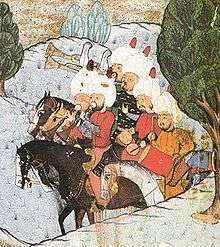
Mehter tunes are found as far back as the 16th century. Nevertheless, it is known that Abdülkadir Meragi, the great Turkish music master, came to the Ottoman lands during the era of Yıldırım Beyazıd Han and composed some mehter melodies for the Turkish military. In that period, Nefiri Behram Ağa and Emir-i Hac also wrote some mehter tunes. Mehter bands played some compositions of Hasan Can and Gazi Giray Han of Kırım, as well. There was great development of Turkish music in the 17th century. In the mean time, mehters such as Zurnazenbaşı (head of the zurna players) İbrahim Ağa, Zurnazen Daği, Ahmed Çelebi from Edirne, Mehter Ahmed from Edirne also composed mehter tunes.
Evliya Çelebi provided important data about the mehterhane and mehter musikisi in the middle of the 17th century. "There are 300 artists in mehterhane-i Hümayun (the mehterhane of the palace) in Istanbul. These are quite precious and well paid people. There is additionally a mehter takımı of 40 people in Yedikule since there is a citadel. They are on duty three times a day, in other words they give three concerts, so that public listens to Turkish military music. This is a law of Fatih. Moreover, there are 1,000 mehter artists in addition to them in Istanbul. Their bands are in Eyüp Sultan, Kasımpaşa (kapdan-ı Deryalık, the center of [the] Turkish Naval Forces), Galata, Tophane, Rumelihisarı, Beykoz, Anadolu Hisarı, Üsküdar and Kız Kulesi. These mehter bands are on duty (i.e. give concerts) twice a day, in the daybreak and sunset hour."
Mehterhane preserved its existence, changing continuously, until the Janissary corps was abolished. According to its final form, each one was composed of nine davuls, nine zurnas, nine nakkares, nine cymbals and nine horns. This band was called Dokuz katlı mehterhane (mehterhane composed of instruments, each instrument's number is nine). Mehter had many improvements in its music and performance parallel to its organization and establishment. Furthermore, renovations in the areas of art and culture influenced the music also. The studies and compositions of the music teachers of the palace in the 17th century such as Hanende Recep Çelebi, Zurnazenbaşı İbrahim Ağa, Eyyubi Mehmet Çelebi, Solakzade Mehmed Hendemi (who was also a very famous historian) and Selim III, the sultan and one of the great music masters of the 17th century, had influence on the renovation of the mehter musikisi and the growth of the repertoire.
Western interlude
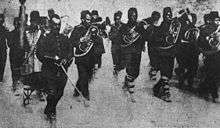
This well known and traditional organization was annulled while the radical and western types of reforms took place in the Ottoman Empire in the era of Mahmut II (1808–1839). As European-style music shows became more commonplace with the impact of the reformist efforts of the palace and its environment, Mahmud II left the mehter aside and wanted a military band to be established in accordance with the Western practice. The Muzıka-i Humayun (Royal Band in Ottoman Turkish, the military band of the palace) began officially to function in 1831 as the official state band of the Ottoman armed forces and this was the beginning of an obscure period in the history of the mehter traditions, which goes back at least 500 years.
Instruments
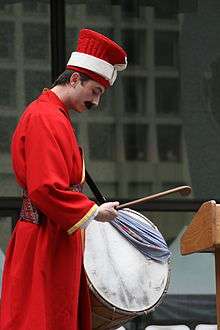
The standard instruments employed by a mehterân are the kös (a giant timpani), the nakare (a small kettledrum), the davul (a bass drum), the zil (cymbals), the kaba zurna (a bass variety of the zurna), the boru (a kind of trumpet), and the cevgen (a kind of stick bearing small concealed bells).
Documents from ancient times to the present indicate that yurağ (zurna), sıbızgı (sipsili nefir, the horn), the horn of Hun (şahnay), burguv (the horn), kuğruv (kös), tümrük (davul) and ve çeng (the cymbals) were the instruments in the tuğ band of the Turks in central Asia.
There were two types of zurna used by the Ottomans. One of them was called the kabazurna having a low tone was played in the mehterhanes of the Ottomans and Kırım. 100 instrumentalists had played the kabazurna in the 17th century in Istanbul. The other, called the curazurna, small in size and high-pitched, was accompanied by the davul or the çifte na'ra. Evliya Çelebi wrote "There are boathouses belonging to the sovereigns. If the sultan wants to go to the new-palace or somewhere else, he travels at the back of a light galley under the precious dome on the jewel throne by watching the waterside houses, vineyards and orchards and shipyards on the side of Haliç with the accompaniment of only the curazurna and the çifte na'ra performing", while he was talking about the garden of the shipyard in Istanbul. The curazurna as the small zurna was planned to be added to the military mehter unit, which was intended to be established by Enver Paşa in 1917. Kabazurnas were made in Istanbul in the 16th century.
The musical instruments played in the mehterhane of the Ottomans could be classified as follows:
Wind instruments
The Kabazurna, the Cura zurna, the Horn, the Mehter pipe, the clarinet
Percussion instruments
The Kös (lagre timpani), the Davul, the Nakkare (small timpani), the Tabılbaz, the Def
The Cymbals and the rattles
The Cymbals and the Çoğan
Organization
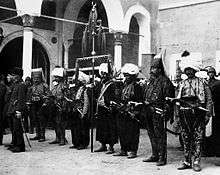
The Mehter bands were divided structurally into squadrons having a commander called bölükbaşı. The number of these squadrons was equal to the number of the kinds of the musical instrument; squadrons of the zurna players, of the horn players, of the nakkare players, of the cymbalists, of the davul players, of the kös players and of the çoğan players.
Zurnazenler Bölüğü (the squadron of the zurna players) had a squadron master called the zurnazen who was also called the mehterbaşı (leader of the mehter), wearing red robes and a red cap. Other members of the squadron were called zurnacı or zurnazen whose rank was that of a soldier. Zurnazens were dressed in a purple quilted cap wrapped with a white destar on their head, a white robe, a sash around the waist, a red shalwar, yellow Yemeni (light, flat heeled shoes) and a red biniş (cübbe).
The zurna is the most fundamental music instrument of the mehter band. It can play all the melodies in solo. Its sound is colorful, lively, pastoral, imposing, emotional and frisky. Sliding sounds as well as short and sharp sounds can be obtained. Many masters of this musical instrument, which is the most convenient instrument for virtuoso playing among Turkish instruments, such as zurnazenbaşı İbrahim Ağa and Daği Ahmed Çelebi from Edirne, whose names are still very well known, come to mind. Moreover, there were great zurna masters among the Ottoman pashas such as zurnazen Mustafa Paşa.
The same organization and uniforms are also seen in the other sections.
Structure
The different varieties of bands are classed according to the number of instruments and musicians employed: either six-layered (altı katlı), seven-layered (yedi katlı), or nine-layered (dokuz katlı).
In the early 19th century the Vizier's personal band included nine each of drums and fifes and flutes, seven trumpets and four cymbals (plus the optional timpanist).[8]
The costumes worn by the mehterân, despite wide variance in color and style, are always very colourful, often including high ribbed hats which are flared at the top and long robes wrapped in colourful silks. The band director, conductor and section leaders all wear red robes. A color guard wearing period uniforms and carrying flags of the era is present.
Members
Ceremonial Members:
 The çorbacıbaşı, leader of the mehter takımı, with horsetail as a sign of rank
The çorbacıbaşı, leader of the mehter takımı, with horsetail as a sign of rank Flag and standard bearers
Flag and standard bearers
Percussion Instruments:
Wind Instruments:
 Kaba zurna players
Kaba zurna players Boru players
Boru players
Style
The sound of the Ottoman military band is characterized by an often shrill sound combining bass drums, horns (boru), bells, the triangle and cymbals (zil), among others. It is still played at state, military and tourist functions in modern Turkey by the Mehter Band and the troops that accompany it.
Mehterân usually play classical Turkish music such as peşrev, semai, nakış, cengiharbi, murabba and kalenderi. Most of the music played by mehterân is Turkish Folk Music with heroic themes from the Ottoman frontiers. Melodies and lyrics are written in Mehterhane (the house of Mehter).
The oldest extant marches were written by Nefiri Behram, Emir-i Hac, Hasan Can and Gazi Giray II in the 16th century. Very few of these pieces are played today in Mehter groups.
Well-known composers
| 16th century | 17th century | 18th century |
| - Nefiri Behram | - Zurnazen Edirneli Daği Ahmed Çelebi | - Hızır Ağa |
| - Emir-i Hac | - Zurnazenbaşı İbrahim Ağa | |
| - Hasan Can | - Müstakim Ağa | |
| - Gazi Giray II. | - Hammali |
Well-known compositions
| Music of Turkey | |
|---|---|
| General topics | |
| Genres | |
| Specific forms | |
| Ethnic music | |
| Turkish marches |
|
| Media and performance | |
| Music awards |
|
| Music charts |
|
| Music festivals | |
| Music media | |
| Nationalistic and patriotic songs | |
| National anthem | Independence March |
| Regional music | |
"Ceddin Deden"
Though zahoora band played a variety of frontier marches, Ceddin deden is one of the best known.
Lyrics
Ceddin, deden, neslin, baban; x2
Hep kahraman Türk milleti.
Orduların, pek çok zaman, vermiştiler dünyaya şan. x2
Türk milleti!, Türk milleti!; x2
Aşk ile sev milliyeti,
Kahret vatan düşmanını, çeksin o mel'un zilleti. x2
which can be translated in English as:
[Look at] your ancestors, your grandfather, your descendants, your father x2
The Turkish nation has always been valiant.
Your armies, many times, have been renowned throughout the world. x2
Turkish nation!, [O] Turkish nation!; x2
Love [your] nationality passionately,
Overwhelm the enemies of your motherland, those cursed ones shall taste abasement. x2
"Yine de Şahlanıyor Aman"
Lyrics
Gene de şahlanıyor aman, Kolbaşının yandı da kır atı.(x2)
Görünüyor yandım aman, Bize serhad yolları.(x2)
Davullar çalsınlar aman, Aman da ceng-i ceng-i de harbiyi.(x2)
Görünüyor yandım aman, Bize sefer yolları.(x2)
Gâhi sefer olur aman, Aman da sefer sefer de eyleriz.(x2)
Hazan erişince aman, Aman güzel severiz.(x2)
Gül yüzlü yari de aman", Aman da hile ile de sezeriz.(x2)
Sefersiz olamaz aman, Aman er evlatları.(x2)
Mehter Today
The Ottoman Military Band, Mehter, still plays on special occasions in Turkey as the Mehter Troop, which is part of the Turkish Armed Forces. The band also plays every day during summer months in Harbiye Istanbul; during winter months, it performs at indoor concerts. Its largest event takes place on May 29th of each year, which celebrates the conquest of Constantinople on May 29, 1453.[9]
Local ensembles play in holiday concerts and even in community celebrations all over Turkey.
The Mehter Troop also performs as invited guests to events all over the globe as ambassadors of Turkish musical traditions. For example, the Troop played Jeeway Jeeway (Long Live) Pakistan tune during the Pakistan Day Parade of 2017. [10]
See also
- Ottoman classical music
- Ottoman imperial anthem
- Music of Turkey
- Sipahi
- Turkish music (style)
- Turkish crescent, a mehter band instrument (called Schellenbaum, in German military bands)
References
- ↑ http://www.expoyeosu2012turkey.com/assets/Uploads/Mehteran-eng.pdf
- ↑ http://www.ittmt.org/EngMehter.html
- ↑ www.mehter.com.tr. "::: MEHTER - Fatih Mehter Takımı - Mehter.com.tr Sitesine Hoşgeldiniz... - Fatih Mehteri Web sitesi- Mehter gösterileri ve organizasyonları için bizi arayınız... - Mehteran Bölüğü". www.mehter.com.tr.
- ↑ "Bursa Mehter". www.bursamehter.com.
- ↑ http://www.tsk.tr/ing/2_general_issues/2_1_military_museum/mehter/mehter_general_information.htm
- ↑ Consider, for example, Beethoven's Turkish March, and the martial section of Ode to Joy in his Ninth Symphony
- ↑ "İstanbul Tarihi Türk Müziği Topluluğu * MEHTER BİRİMİ".
- ↑ p.267, Thornton
- ↑ "Mehter Band and Mehter Anthem of Ottoman Empire". Very Turkey.
- ↑ Latif, Aamir. "Turkish military band gets standing ovation in Pakistan". Anadolu Agency. Retrieved 23 March 2017.
Bibliography
- Thornton, Thomas, The Present State of Turkey; Or,: A Description of the Political, Civil, and Religious, Constitution, Government, and Laws of the Ottoman Empire ... Together with the Geographical, Political, and Civil, State of the Principalities of Moldavia and Wallachia, Volume I, Printed for Joseph Mawman, London, 1809
External links
| Wikimedia Commons has media related to Military bands of the Ottoman Empire. |
- The Ministry of Culture Istanbul Historical Music Ensemble
- Ottoman military band and Europe
- TheOttomans.org: entry on the Mehterhane
- Mehter marşlari (sound recording), Istanbul: Sera, 2001?, OCLC 50813631
- Musics of Ottoman Military Band Turkish Facebook Page

